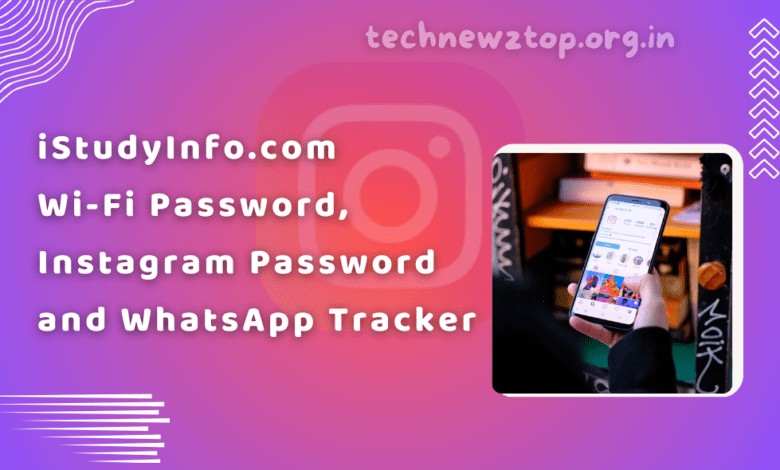iStudyInfo.com WiFi Password – Complete Guide to Secure Your Network

In today’s digital era, a WiFi connection is essential for communication, work, entertainment, and education. Whether at home, in an office, or in public places, having access to a secure and reliable WiFi network is crucial. However, many users struggle with managing their WiFi passwords, retrieving them when forgotten, or sharing them securely with others.
This guide, published by Technewztop, will walk you through everything you need to know about the iStudyInfo.com WiFi Password, security protocols, retrieval methods, ethical considerations, and best practices for maintaining a secure network.
What is a WiFi Password?
A WiFi password, also called a network security key, is a unique combination of characters used to authenticate and protect access to a wireless network. Without a proper password, unauthorized users can exploit your network, leading to security risks, data breaches, and slower internet speeds.
Why is a WiFi Password Important?
- Network Security: Prevents unauthorized users from accessing your WiFi.
- Data Protection: Safeguards your personal information from hackers.
- Bandwidth Management: Ensures only trusted users consume network resources.
- Prevention of Cyber Threats: Reduces the risk of hacking, phishing, and malware attacks.
Types of WiFi Security Protocols
Understanding different WiFi security protocols helps in selecting the most secure option for your network.
1. WEP (Wired Equivalent Privacy)
- Outdated and weak security protocol.
- Easily hacked using modern tools.
- Not recommended for protecting sensitive data.
2. WPA (WiFi Protected Access)
- Improved security over WEP.
- Uses stronger encryption but still vulnerable to attacks.
3. WPA2 (WiFi Protected Access II)
- Most widely used and secure protocol.
- Strong encryption and better resistance to brute-force attacks.
- Recommended for personal and professional networks.
4. WPA3 (WiFi Protected Access III)
- Latest security standard.
- Provides enhanced encryption and protection against cyber threats.
- Offers better defense against brute-force attacks.
Technewztop suggests using WPA2 or WPA3 security for maximum network protection.
Why You May Need to Retrieve a WiFi Password?
There are several reasons why you might need to recover a forgotten iStudyInfo.com WiFi Password:
- Setting Up a New Device: You need to connect a new laptop, mobile, or tablet.
- Helping Family & Friends: Assisting someone in joining your network.
- Network Troubleshooting: Fixing connectivity issues.
- Restoring Access: If you have forgotten your saved password.
How to Retrieve iStudyInfo.com WiFi Password on Different Devices?
There are multiple ways to find a saved WiFi password depending on the operating system you are using.
1. Windows Devices
Method 1: Using Command Prompt
1️⃣ Open Command Prompt (Run as Administrator).
2️⃣ Type the command:
3️⃣ Identify the WiFi network name you want to retrieve.
4️⃣ Enter the following command (replace NetworkName with your actual WiFi name):
5️⃣ Your password will be displayed under “Key Content”.
Method 2: Using Network Settings
1️⃣ Go to Control Panel > Network and Sharing Center.
2️⃣ Click on the active WiFi network.
3️⃣ In the Wireless Properties window, go to the Security tab.
4️⃣ Check the “Show Characters” box to view the password.
2. macOS Devices
Using Keychain Access
1️⃣ Open Keychain Access from Applications > Utilities.
2️⃣ Search for the WiFi network name.
3️⃣ Double-click on the network entry.
4️⃣ Check “Show password” and enter your macOS password.
3. Android Devices
Method 1: Using WiFi Settings
1️⃣ Go to Settings > Network & Internet > WiFi.
2️⃣ Tap the connected WiFi network.
3️⃣ If available, tap “Share” to generate a QR code for easy sharing.
Method 2: Using Third-Party Apps
1️⃣ Install a WiFi password viewer app from the Google Play Store.
2️⃣ Follow the app’s instructions to retrieve saved WiFi passwords.
4. iOS Devices (iPhone & iPad)
Using iCloud Keychain
1️⃣ Make sure iCloud Keychain is enabled.
2️⃣ Open Settings > Passwords.
3️⃣ Search for the WiFi network name and view the saved password.
Ethical and Legal Considerations
When retrieving or sharing a WiFi password, always follow ethical and legal guidelines.
🔹 Obtain Permission: Never access a WiFi network without the owner’s consent.
🔹 Respect Privacy: Do not share passwords publicly or with unauthorized users.
🔹 Comply with Laws: Unauthorized access to a network can result in legal action.
Warning: In many countries, hacking into WiFi networks is illegal and can lead to fines or imprisonment.
Alternative Ways to Share WiFi Access Securely
1. Guest Networks
Many routers allow setting up a guest WiFi network, enabling visitors to connect without sharing the main password.
2. QR Code Sharing
Generate a WiFi QR code so users can scan and connect without manually entering the password.
3. Built-in WiFi Sharing
Some devices (like Android and iPhones) allow password sharing between trusted contacts.
Pros and Cons of Using WiFi Password Management Tools
Advantages:
- Convenient – Easily retrieve stored passwords.
- Secure – Protects against password loss.
- Multi-Device Support – Works across different operating systems.
Disadvantages:
- Privacy Risks – Some apps may store or misuse your credentials.
- Legal Concerns – Unauthorized access to a network is illegal.
Technewztop recommends using trusted WiFi password managers for secure password storage.
Frequently Asked Questions | iStudyInfo.com WiFi Password
Is it legal to retrieve a WiFi password?
Yes, if you own the network or have permission from the owner.
Can I recover a WiFi password without permission?
No, accessing a WiFi network without consent is illegal.
Are iStudyInfo.com WiFi Password recovery apps safe?
Only use apps from trusted sources to avoid security risks.
How can I securely share my WiFi password?
Use guest networks, QR codes, or built-in sharing features.
Conclusion | iStudyInfo.com WiFi Password
Managing and securing your iStudyInfo.com WiFi Password is crucial for protecting your network from unauthorized access and cyber threats. By following the right methods, you can retrieve, share, and secure your WiFi password safely.



